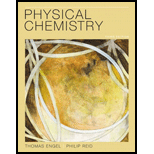
Interpretation:
The reason for observing pure rotational spectrum in microwave region while rotational vibrational spectrum in infrared region and not pure vibrational spectrum should be explained.
Concept Introduction:
The spectroscopy which is observed in microwave region in the
Explanation of Solution
In electromagnetic spectrum; rotational spectroscopy is concerned with microwave region. The rotation of molecule occurs in the microwave region.
If a molecule consists permanent dipole moment, it is microwave active, whereas if molecule does not have permanent dipole moment or there is no interaction with microwave region, it is microwave inactive.
For example;
The heteronuclear molecule HCl is microwave active. Assume; HCl molecule to be rigid and fixed in space. So; its translational and vibrational energies are zero.
Consider only rotational energy of HCl molecule; molecule having net positive charge and net negative charge. Therefore; it carries a permanent electric dipole moment.
The selection rule for the microwave spectroscopy as follows:
Due to some net dipole moment; heteronuclear diatomic molecules are microwave active.
Where;
J = rotational quantum number
Rotational vibrational spectrum:
Rotational vibrational spectroscopy is also known as PQR spectrum.
Homonuclear diatomic molecules are microwave inactive and can be explained by Raman spectra.
Homonuclear diatomic molecule are IR inactive and obtained in Raman spectrum.
Raman spectroscopy is occurred when there is a change in the polarizability of molecule due to vibrational or rotational oscillations.
The selection rule for rotational vibrational spectrum as follows:
ΔJ = 0; ±2
ΔV = ±1, ±2, ±3
Where;
J = rotational quantum number
V = vibrational quantum number
So, the rotational vibrational spectrum is observed between the rotational and vibrational spectrum not in pure vibrational spectrum.
Want to see more full solutions like this?
Chapter 19 Solutions
Physical Chemistry
- help draw the moleculearrow_forwardHow to draw this claisen condensation reaction mechanisms/arrow_forwardWrite all of Me Possible Products For each Of the Following reactions. In each case identity all pains of enantiomers, all digsterzoners and all Meso compounds 9. 11-60 11-0-11 V-G Η Η H ~ C-11 +HB+ - 1 H b. पन्ना 171-0-11 H-C-H Н C-C=c-call +HBr Perendez ==arrow_forward
- How can i draw the mechanisms for this molecule?arrow_forwarda. Discuss and explain he difference IN Stability between the Chai and Boat Гольцу от судомехане b. For the Following Molecule draw both possible Clain conformations and explain which one is more stable and for what Reason. H. CH₂ CH₂ H "Harrow_forwarddraw out these molecules pleasearrow_forward
 ChemistryChemistryISBN:9781305957404Author:Steven S. Zumdahl, Susan A. Zumdahl, Donald J. DeCostePublisher:Cengage Learning
ChemistryChemistryISBN:9781305957404Author:Steven S. Zumdahl, Susan A. Zumdahl, Donald J. DeCostePublisher:Cengage Learning ChemistryChemistryISBN:9781259911156Author:Raymond Chang Dr., Jason Overby ProfessorPublisher:McGraw-Hill Education
ChemistryChemistryISBN:9781259911156Author:Raymond Chang Dr., Jason Overby ProfessorPublisher:McGraw-Hill Education Principles of Instrumental AnalysisChemistryISBN:9781305577213Author:Douglas A. Skoog, F. James Holler, Stanley R. CrouchPublisher:Cengage Learning
Principles of Instrumental AnalysisChemistryISBN:9781305577213Author:Douglas A. Skoog, F. James Holler, Stanley R. CrouchPublisher:Cengage Learning Organic ChemistryChemistryISBN:9780078021558Author:Janice Gorzynski Smith Dr.Publisher:McGraw-Hill Education
Organic ChemistryChemistryISBN:9780078021558Author:Janice Gorzynski Smith Dr.Publisher:McGraw-Hill Education Chemistry: Principles and ReactionsChemistryISBN:9781305079373Author:William L. Masterton, Cecile N. HurleyPublisher:Cengage Learning
Chemistry: Principles and ReactionsChemistryISBN:9781305079373Author:William L. Masterton, Cecile N. HurleyPublisher:Cengage Learning Elementary Principles of Chemical Processes, Bind...ChemistryISBN:9781118431221Author:Richard M. Felder, Ronald W. Rousseau, Lisa G. BullardPublisher:WILEY
Elementary Principles of Chemical Processes, Bind...ChemistryISBN:9781118431221Author:Richard M. Felder, Ronald W. Rousseau, Lisa G. BullardPublisher:WILEY





